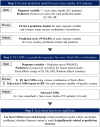Forecasting the spread of COVID-19 based on policy, vaccination, and Omicron data
- PMID: 38693172
- PMCID: PMC11063074
- DOI: 10.1038/s41598-024-58835-9
Forecasting the spread of COVID-19 based on policy, vaccination, and Omicron data
Abstract
The COVID-19 pandemic caused by the novel SARS-COV-2 virus poses a great risk to the world. During the COVID-19 pandemic, observing and forecasting several important indicators of the epidemic (like new confirmed cases, new cases in intensive care unit, and new deaths for each day) helped prepare the appropriate response (e.g., creating additional intensive care unit beds, and implementing strict interventions). Various predictive models and predictor variables have been used to forecast these indicators. However, the impact of prediction models and predictor variables on forecasting performance has not been systematically well analyzed. Here, we compared the forecasting performance using a linear mixed model in terms of prediction models (mathematical, statistical, and AI/machine learning models) and predictor variables (vaccination rate, stringency index, and Omicron variant rate) for seven selected countries with the highest vaccination rates. We decided on our best models based on the Bayesian Information Criterion (BIC) and analyzed the significance of each predictor. Simple models were preferred. The selection of the best prediction models and the use of Omicron variant rate were considered essential in improving prediction accuracies. For the test data period before Omicron variant emergence, the selection of the best models was the most significant factor in improving prediction accuracy. For the test period after Omicron emergence, Omicron variant rate use was considered essential in deciding forecasting accuracy. For prediction models, ARIMA, lightGBM, and TSGLM generally performed well in both test periods. Linear mixed models with country as a random effect has proven that the choice of prediction models and the use of Omicron data was significant in determining forecasting accuracies for the highly vaccinated countries. Relatively simple models, fit with either prediction model or Omicron data, produced best results in enhancing forecasting accuracies with test data.
© 2024. The Author(s).
Conflict of interest statement
The authors declare no competing interests.
Figures



Similar articles
-
An ensemble approach improves the prediction of the COVID-19 pandemic in South Korea.J Glob Health. 2025 Mar 28;15:04079. doi: 10.7189/jogh.15.04079. J Glob Health. 2025. PMID: 40146993 Free PMC article.
-
Real-time forecasting of COVID-19 spread according to protective behavior and vaccination: autoregressive integrated moving average models.BMC Public Health. 2023 Aug 8;23(1):1500. doi: 10.1186/s12889-023-16419-8. BMC Public Health. 2023. PMID: 37553650 Free PMC article.
-
A COVID-19 Pandemic Artificial Intelligence-Based System With Deep Learning Forecasting and Automatic Statistical Data Acquisition: Development and Implementation Study.J Med Internet Res. 2021 May 20;23(5):e27806. doi: 10.2196/27806. J Med Internet Res. 2021. PMID: 33900932 Free PMC article.
-
Molecular evolution of SARS-CoV-2 from December 2019 to August 2022.J Med Virol. 2023 Jan;95(1):e28366. doi: 10.1002/jmv.28366. J Med Virol. 2023. PMID: 36458547 Free PMC article. Review.
-
The Vaccine Efficacy Against the SARS-CoV-2 Omicron: A Systemic Review and Meta-Analysis.Front Public Health. 2022 Jul 13;10:940956. doi: 10.3389/fpubh.2022.940956. eCollection 2022. Front Public Health. 2022. PMID: 35910897 Free PMC article.
Cited by
-
Development and validation of an early diagnosis model for severe mycoplasma pneumonia in children based on interpretable machine learning.Respir Res. 2025 May 13;26(1):182. doi: 10.1186/s12931-025-03262-1. Respir Res. 2025. PMID: 40361124 Free PMC article.
-
An ensemble approach improves the prediction of the COVID-19 pandemic in South Korea.J Glob Health. 2025 Mar 28;15:04079. doi: 10.7189/jogh.15.04079. J Glob Health. 2025. PMID: 40146993 Free PMC article.
References
-
- Worldometer. COVID-19 CORONAVIRUS PANDEMIC [cited 2022 30 December]. https://www.worldometers.info/coronavirus/.
Publication types
MeSH terms
Substances
Supplementary concepts
Grants and funding
LinkOut - more resources
Full Text Sources
Medical
Miscellaneous

